Growing your own herbs at home has never been more popular or practical. Whether you're working with a sprawling backyard or a tiny apartment windowsill, fresh herbs can transform your cooking while adding natural beauty to your space. These twenty creative herb garden ideas offer solutions for every skill level, budget, and living situation, helping you cultivate aromatic, flavorful herbs that enhance both your meals and your environment.
1. Pallet Vertical Herb Garden Wall Display
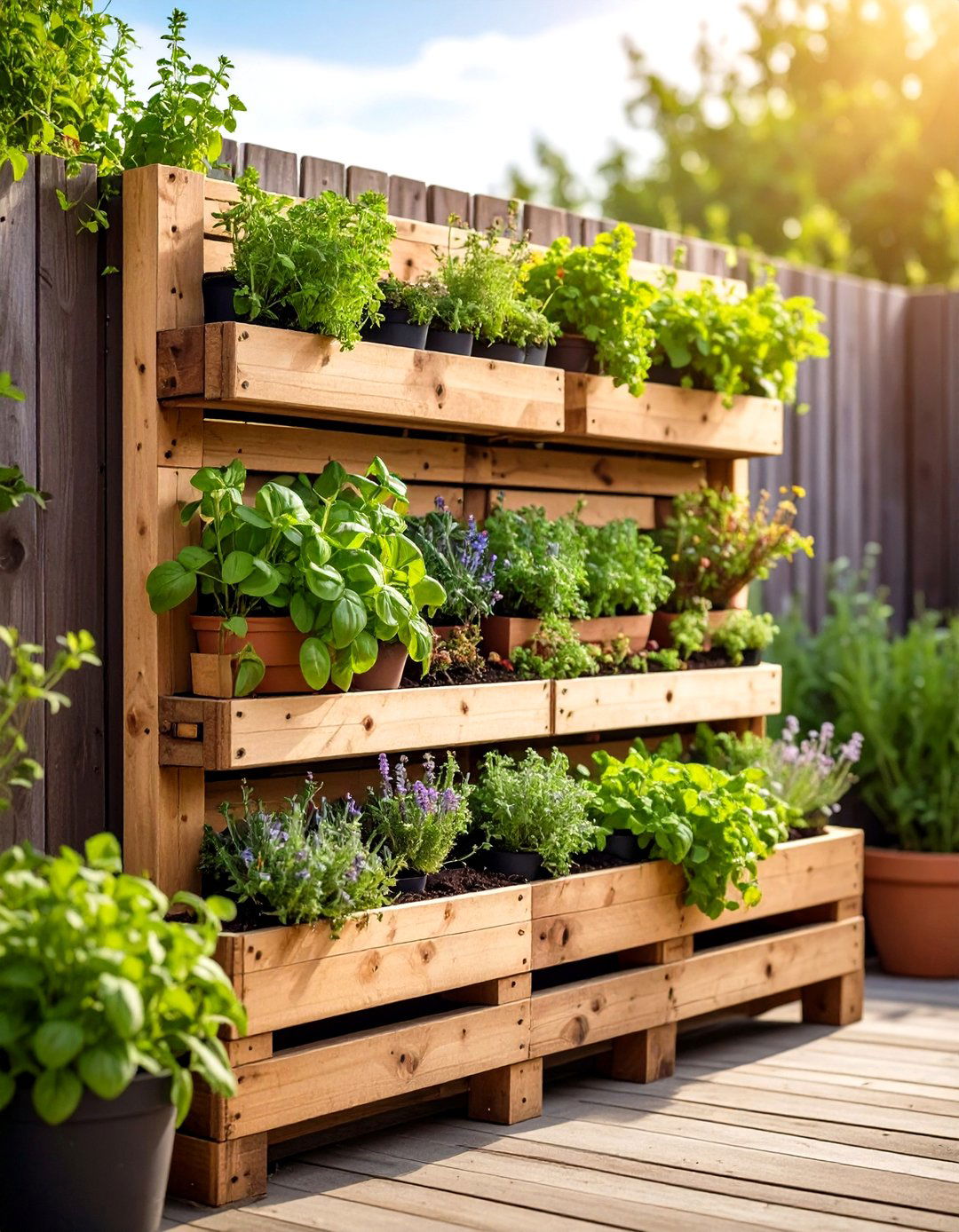
Creating a pallet vertical herb garden transforms an ordinary wooden pallet into a stunning living wall that maximizes growing space in minimal square footage. Position your cleaned, untreated pallet against a fence or wall, then staple landscape fabric between the lower slats to create individual planting pockets. Fill each compartment with quality potting soil and plant different herbs according to their sun requirements. This approach works beautifully for oregano, thyme, basil, and parsley, creating an organized display that's both functional and visually appealing. The pallet's natural wood aesthetic complements any outdoor décor while providing easy access for daily harvesting.
2. Kitchen Windowsill Herb Garden Collection
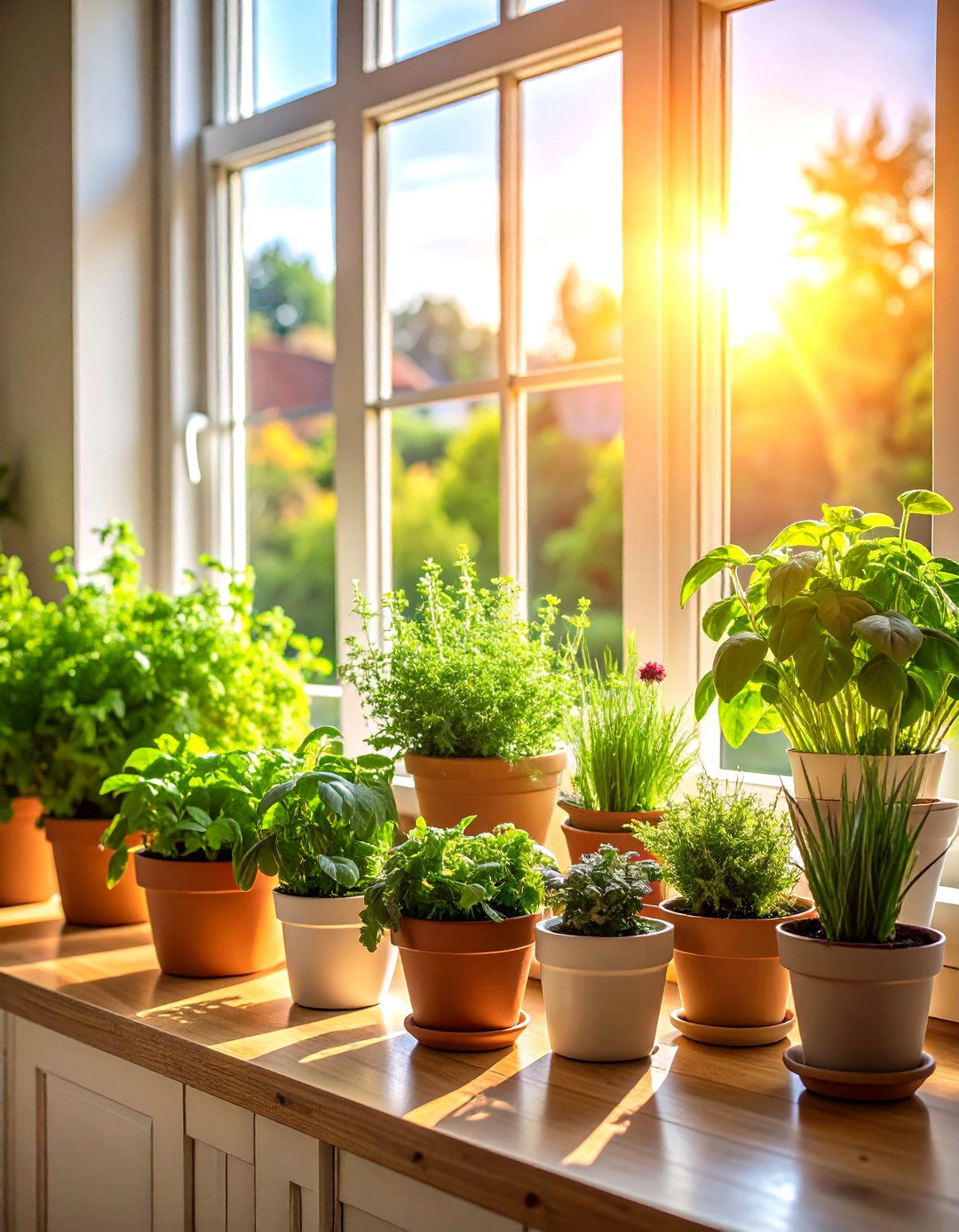
A kitchen windowsill herb garden places fresh flavors directly at your fingertips while you cook, making it the most convenient growing method for busy home chefs. Choose containers 4-6 inches deep with proper drainage, arranging basil, parsley, cilantro, and chives where they'll receive at least six hours of daily sunlight. South-facing windows provide ideal light conditions, though supplemental grow lights can extend growing possibilities. Water when the top inch of soil feels dry, and pinch flowers regularly to encourage continued leaf production. This setup allows you to snip fresh herbs while preparing meals, ensuring maximum flavor and nutritional value in your culinary creations.
3. Spiral Herb Garden Raised Bed Design
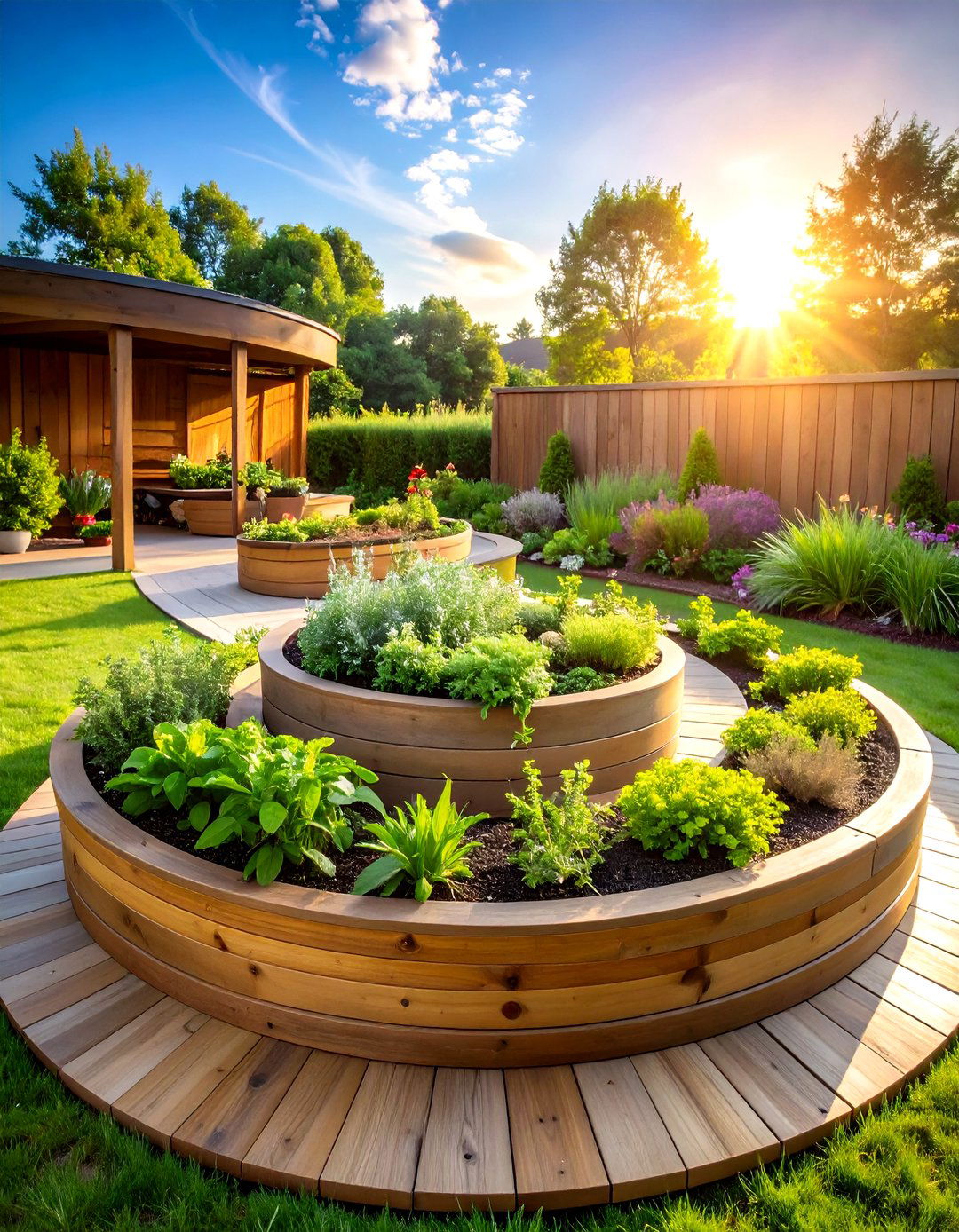
An herb spiral garden creates multiple microclimates within a compact circular space, allowing you to grow diverse herbs with varying water and sun requirements. Build your spiral using stones, bricks, or timber, starting low at the outer edge and ascending to approximately three feet at the center. Plant sun-loving Mediterranean herbs like rosemary and oregano at the top where drainage is excellent, while positioning moisture-loving herbs like mint and parsley at the bottom. The thermal mass of the stone walls stores heat during the day and releases it at night, extending your growing season while creating an attractive garden focal point.
4. Hanging Mason Jar Herb Garden System

Transform ordinary mason jars into a charming hanging herb garden that adds rustic appeal to any indoor or outdoor space. Drill drainage holes in jar lids, attach hose clamps or wire hangers, and mount them at varying heights along a wooden board or fence. This system works particularly well for smaller herbs like oregano, thyme, and mint that don't require extensive root space. The clear glass allows you to monitor soil moisture levels easily while creating an attractive display that complements farmhouse or cottage-style décor. Regular harvesting keeps plants compact and productive throughout the growing season.
5. Rolling Container Herb Garden Station
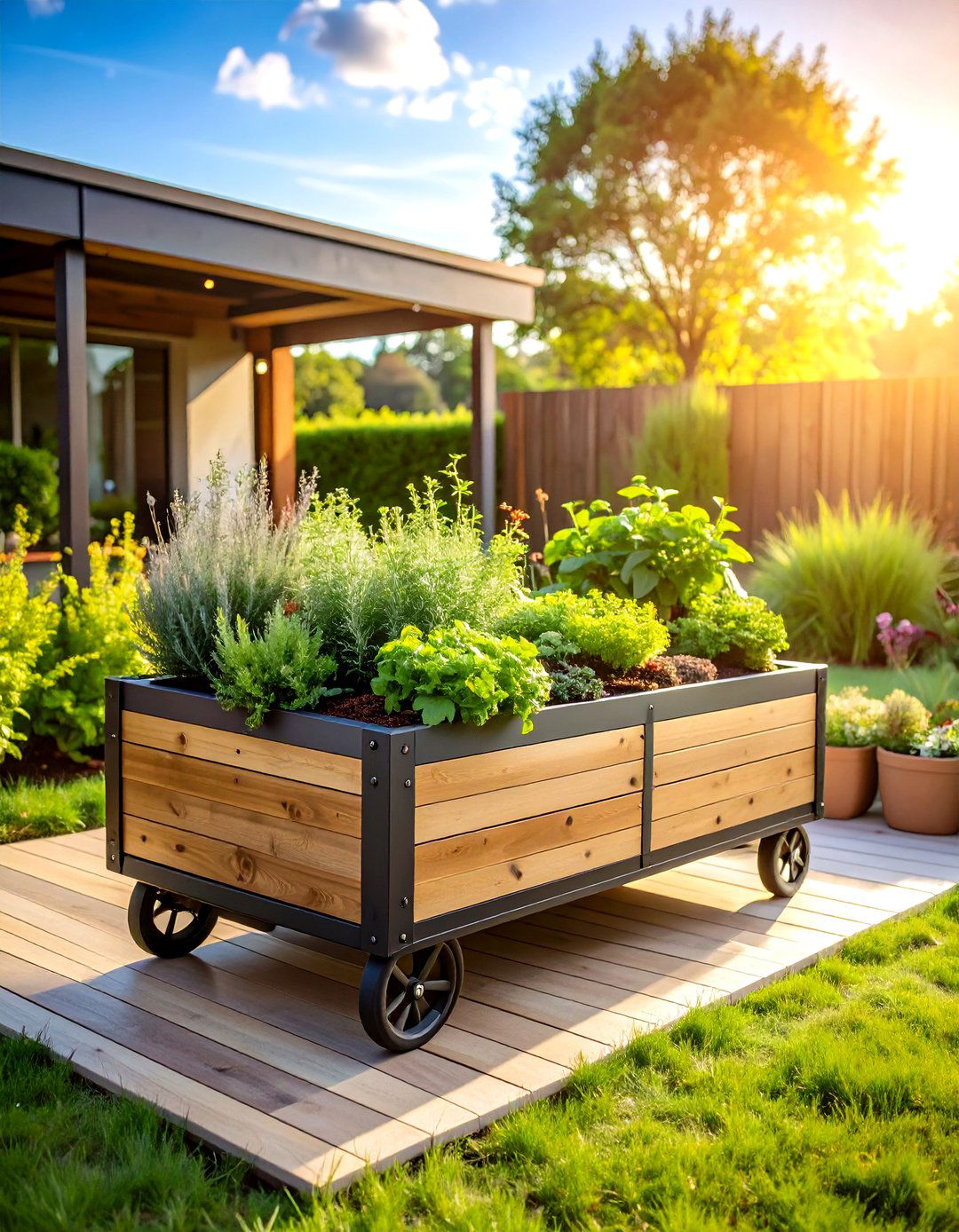
A rolling container herb garden provides ultimate flexibility, allowing you to chase sunlight throughout the day or move plants indoors during harsh weather. Use a large, wheeled planter box or construct a mobile unit with casters, ensuring adequate drainage and soil depth for herb root systems. Plant compatible herbs together based on water requirements, grouping Mediterranean varieties like lavender, sage, and rosemary separately from moisture-loving herbs like cilantro and parsley. This mobility proves especially valuable for renters or gardeners who want to optimize growing conditions while maintaining easy access for daily cooking needs.
6. Vintage Tea Cup Herb Garden Miniatures
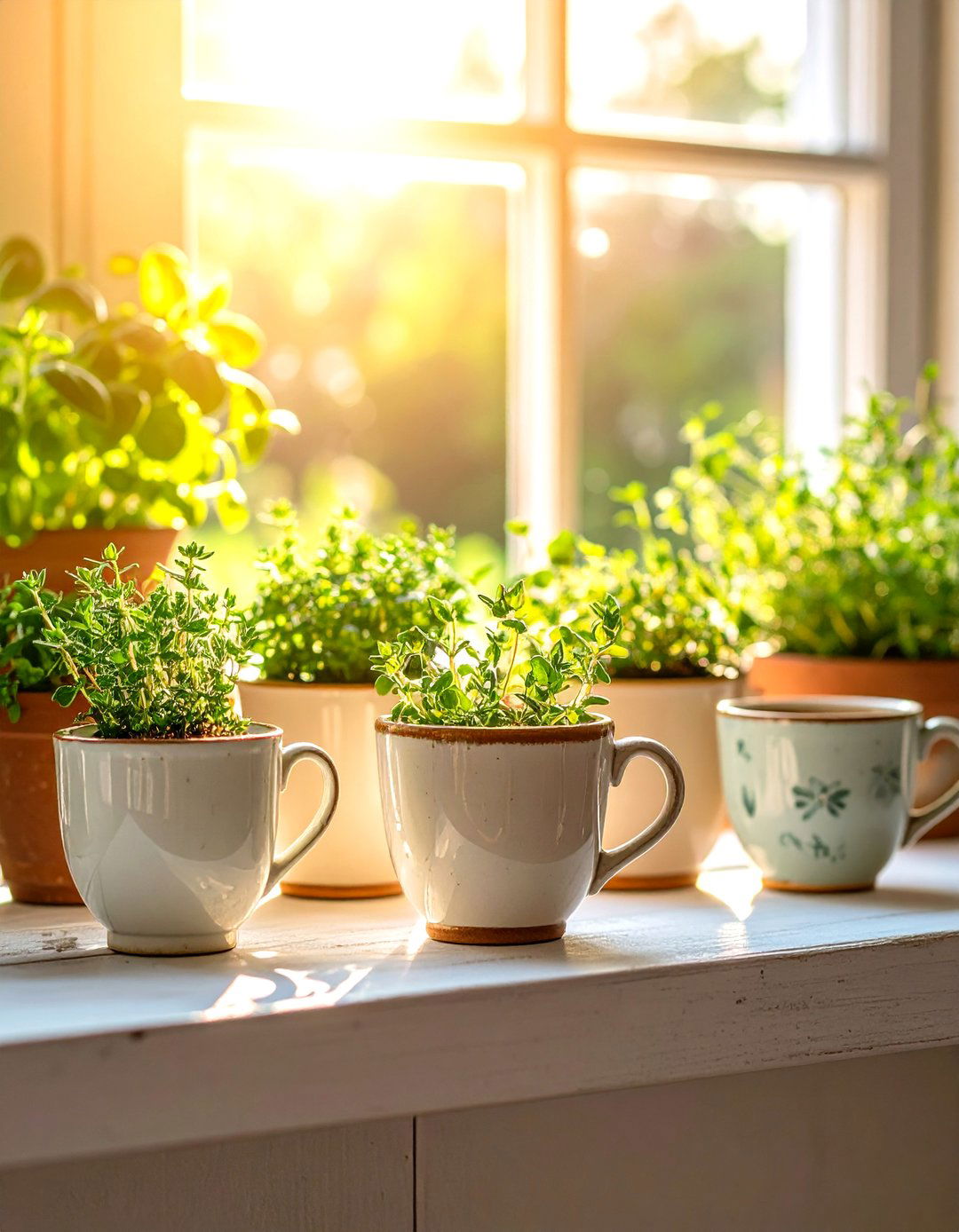
Create enchanting vintage tea cup herb gardens by repurposing delicate porcelain cups and saucers into miniature growing containers perfect for windowsill displays. Choose small, shallow-rooted herbs like thyme, oregano, or small basil varieties that won't outgrow their charming containers quickly. Add small drainage holes or use the tea cups as decorative outer containers for properly draining inner pots. These whimsical gardens work beautifully as kitchen décor, adding elegance while providing fresh herbs for garnishing and flavoring. The vintage aesthetic appeals to antique lovers while offering a unique conversation piece for guests.
7. Galvanized Tub Herb Garden Container
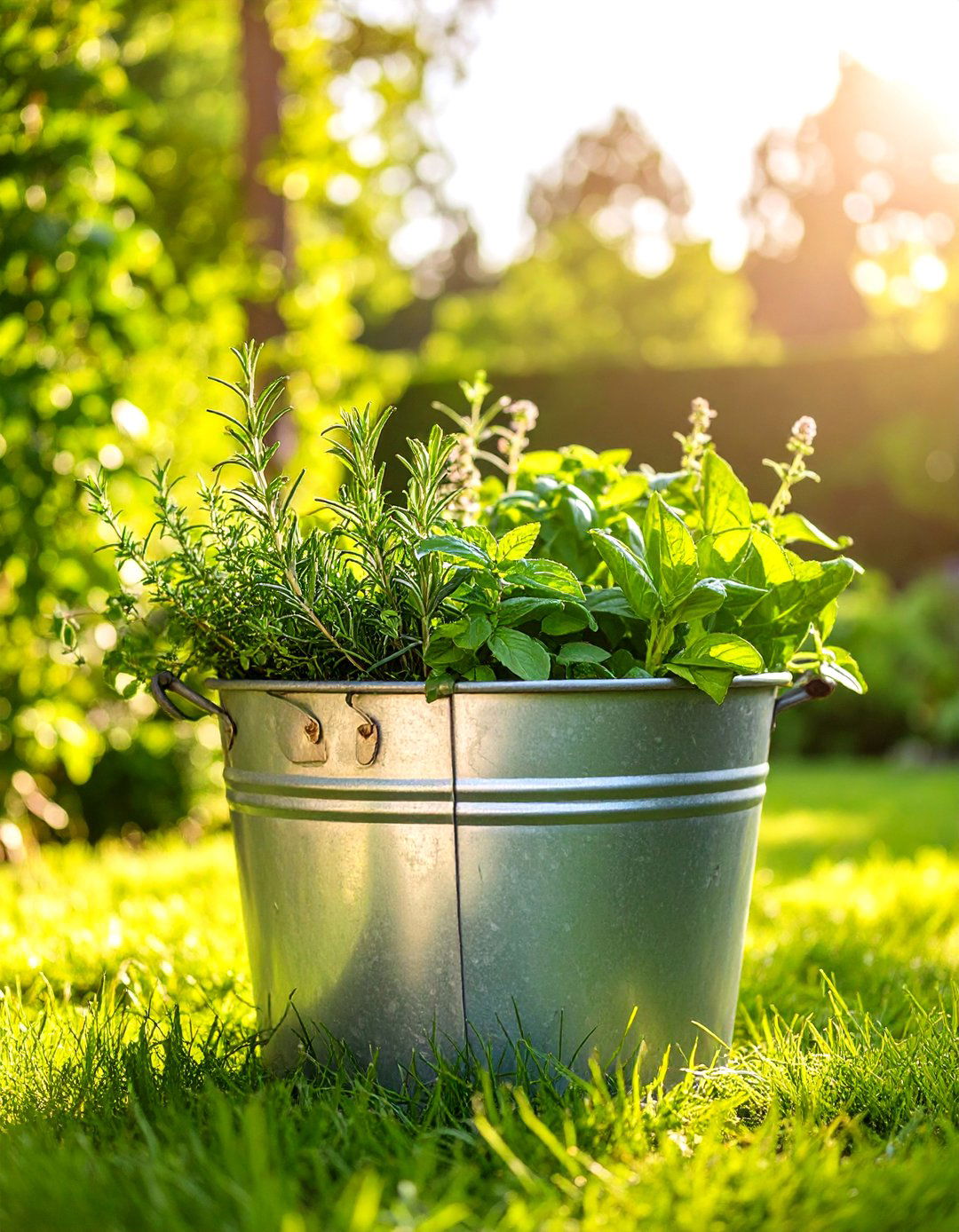
A galvanized metal tub herb garden combines rustic farmhouse style with practical growing space, accommodating multiple herb varieties in one attractive container. Choose food-grade galvanized materials to ensure plant safety, drilling adequate drainage holes throughout the bottom. The large surface area allows for companion planting arrangements, grouping herbs with similar water and light requirements while creating visually appealing combinations. Position taller herbs like rosemary toward the back, with trailing varieties like oregano spilling over the edges. This container style weathers beautifully outdoors while providing enough space for a substantial herb harvest throughout the growing season.
8. Ladder Shelf Tiered Herb Garden Structure

Transform an old wooden ladder into a multi-level herb garden that maximizes vertical growing space while adding architectural interest to your garden or patio. Position planters or pots on each ladder rung, arranging them according to plant height and sun requirements. This tiered approach allows you to grow numerous herb varieties in a small footprint while creating easy access for maintenance and harvesting. The varying heights provide natural drainage flow and air circulation, reducing disease risks while showcasing your herb collection beautifully. Paint or stain the ladder to complement your outdoor décor while ensuring weather resistance for long-term durability.
9. Self-Watering Window Box Herb Garden
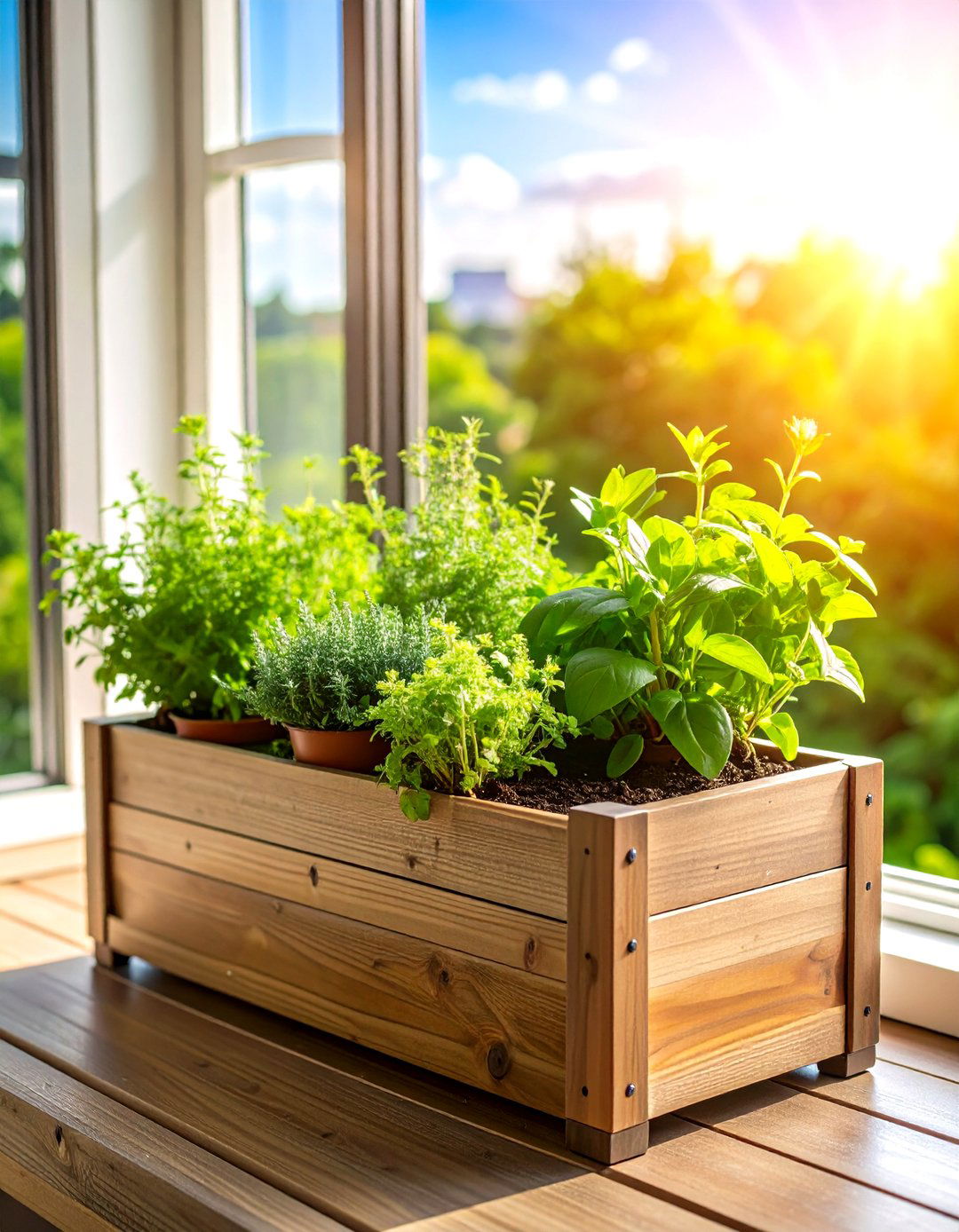
Window box herb gardens with self-watering systems provide consistent moisture control while maximizing growing space along sunny windows or deck railings. These specialized containers include water reservoirs that supply steady moisture through capillary action, perfect for herbs like spearmint, oregano, rosemary, and thyme. Install boxes on south or west-facing windows for optimal light exposure, ensuring at least six hours of direct sunlight daily. The self-watering feature proves especially valuable during vacation periods or busy schedules, maintaining healthy plants without daily attention while keeping fresh herbs within easy reach of your kitchen.
10. Repurposed Rain Gutter Herb Garden System
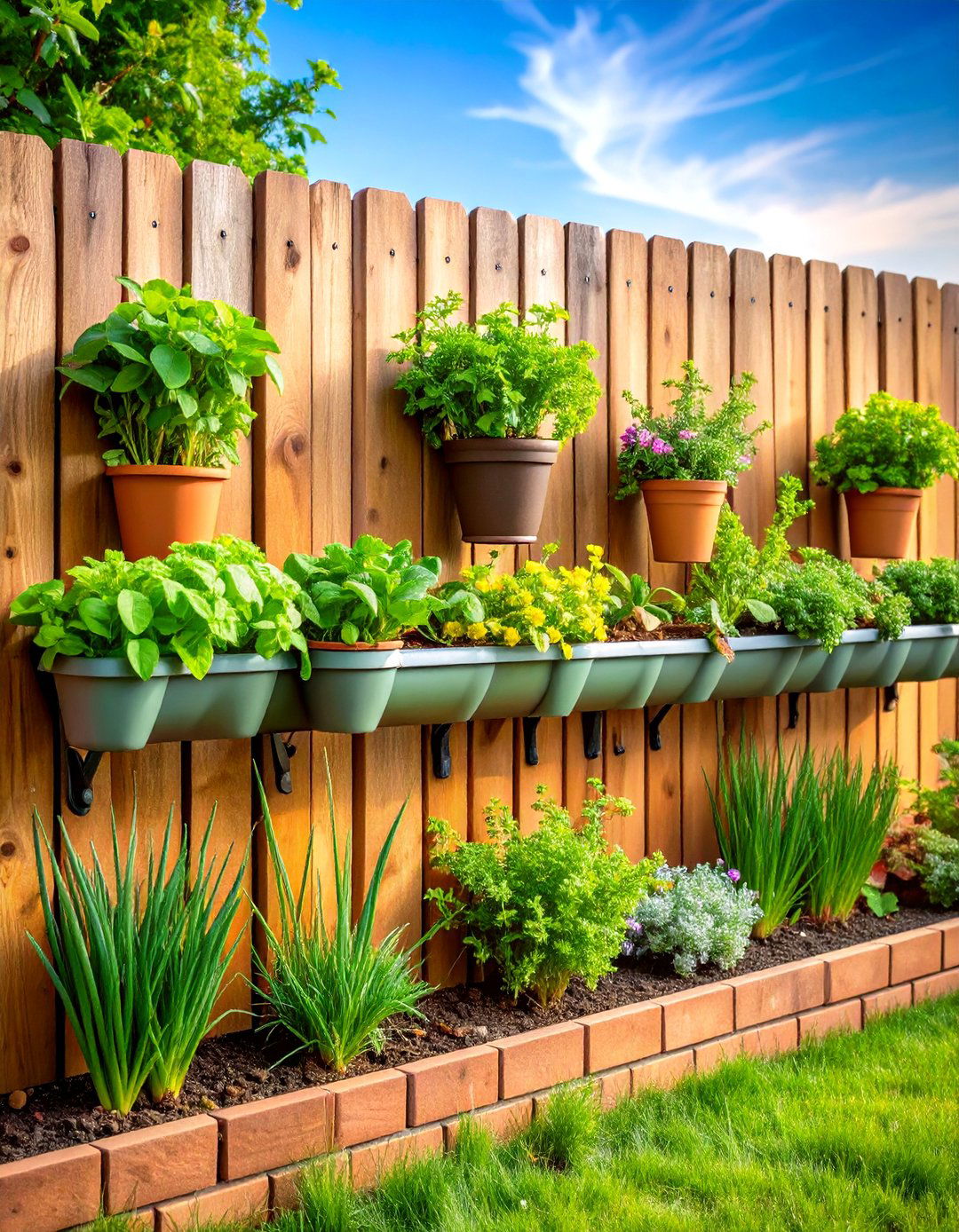
Create an innovative repurposed rain gutter herb garden by mounting cleaned gutters horizontally along fences, deck railings, or walls to form narrow growing channels perfect for shallow-rooted herbs. Cap the ends and drill drainage holes every six inches to prevent water accumulation, then fill with lightweight potting mix suitable for container growing. This system works exceptionally well for lettuce-style herbs, chives, and small basil plants while providing excellent space efficiency. The linear design allows for organized planting arrangements while maintaining easy access for harvesting and maintenance throughout the growing season.
11. Fabric Pocket Vertical Herb Garden Wall
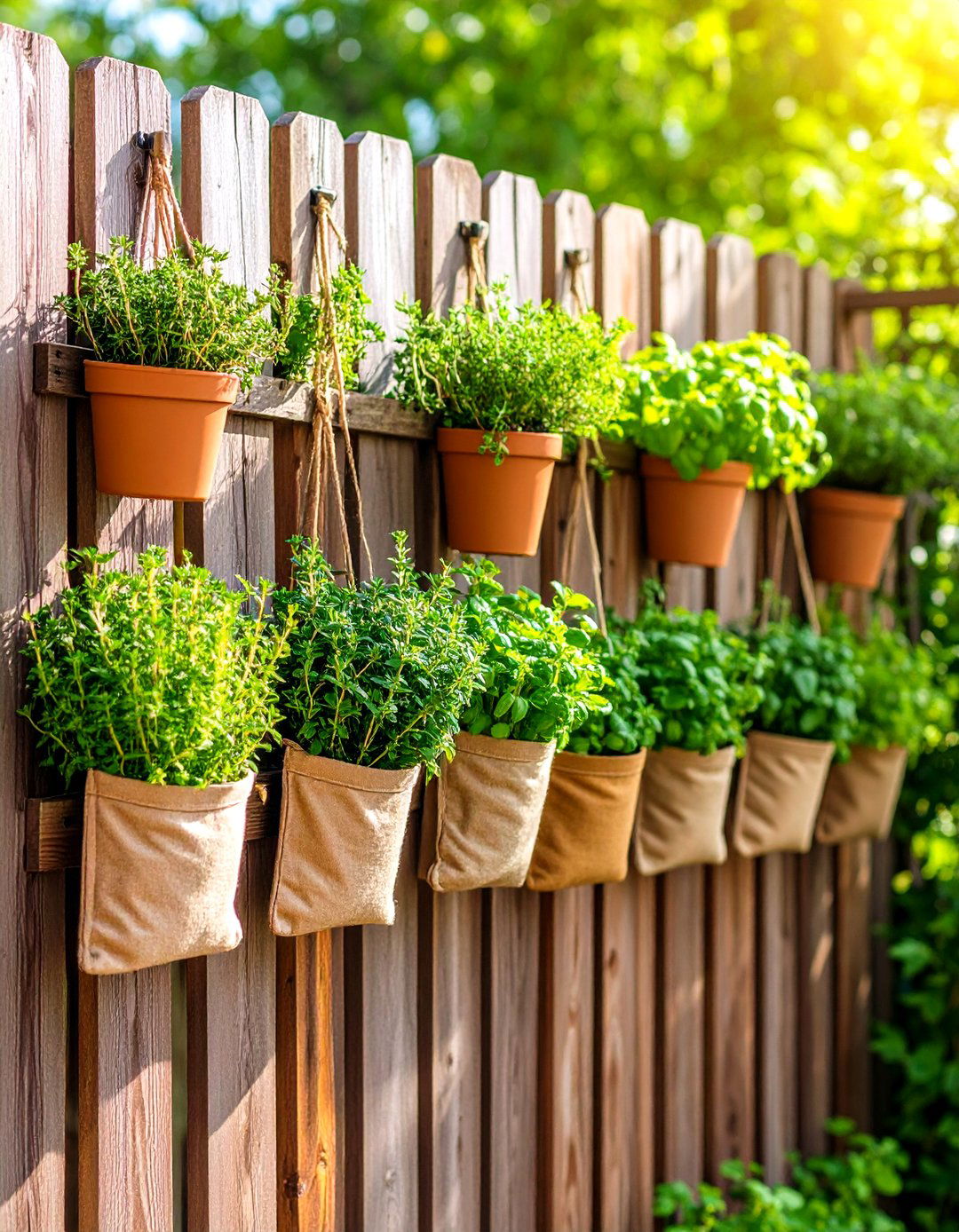
Fabric pocket vertical herb gardens utilize hanging organizers or specially designed felt pouches to create space-efficient growing walls perfect for small patios or indoor spaces. These lightweight systems attach easily to fences, walls, or balcony railings without requiring permanent installation, making them ideal for renters. Plant compact herbs like thyme, oregano, parsley, and chives in individual pockets, ensuring proper drainage to prevent root rot. The fabric material allows for adequate aeration while the vertical arrangement maximizes growing space. Regular harvesting keeps plants compact while providing fresh herbs for daily cooking needs.
12. Wooden Crate Herb Garden Collection
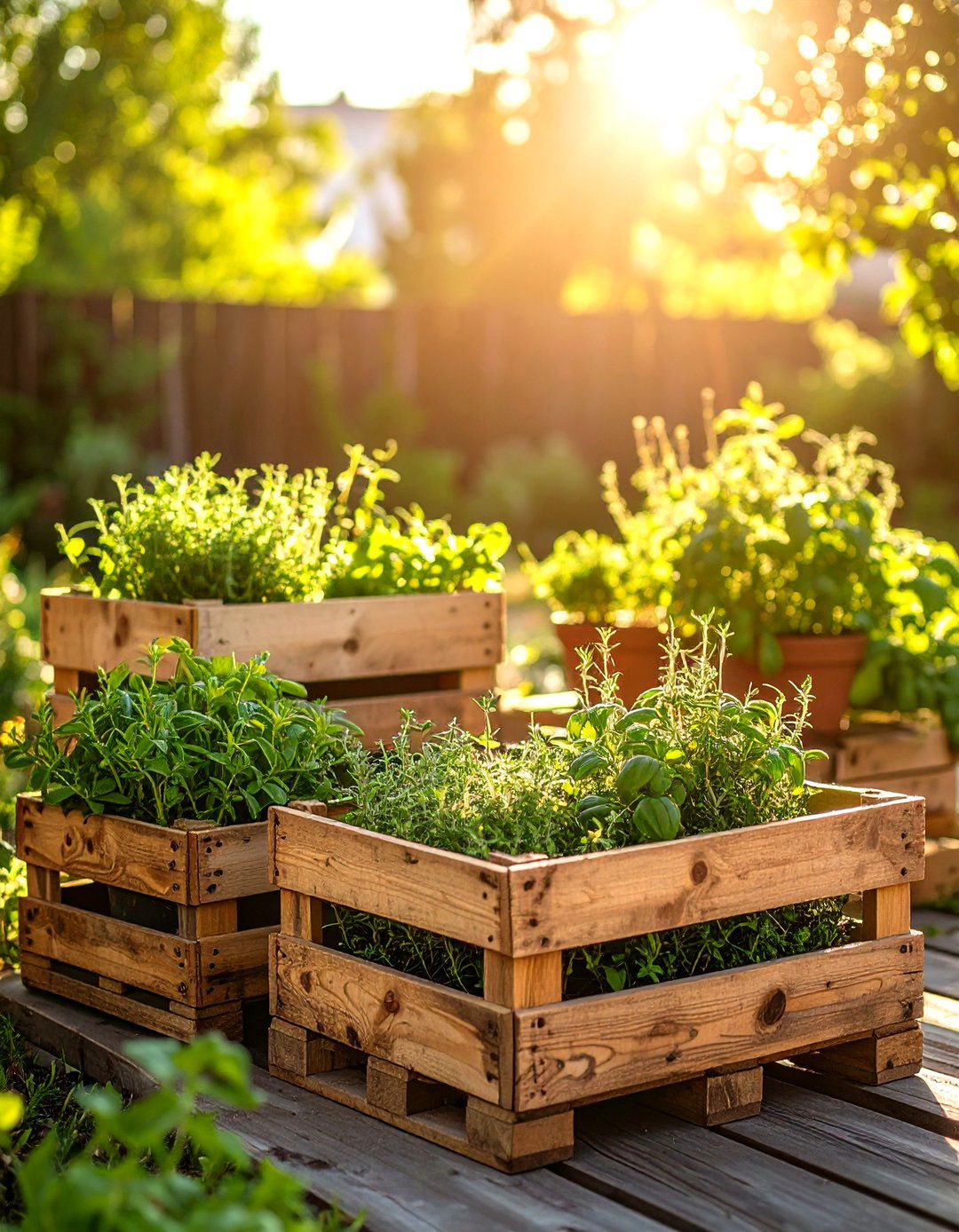
Vintage wooden crates create charming herb garden containers that add rustic appeal while providing ample growing space for multiple herb varieties. Line crates with landscape fabric to retain soil while allowing proper drainage, then arrange them at varying heights to create visual interest and optimize light exposure. Group herbs with similar growing requirements within each crate, creating themed collections like Mediterranean herbs, tea herbs, or culinary essentials. The weathered wood aesthetic complements farmhouse and cottage garden styles while providing sturdy, long-lasting containers that develop beautiful patina over time through outdoor exposure.
13. Hanging Basket Cascade Herb Garden

Hanging basket herb gardens create stunning cascading displays while maximizing vertical growing space in areas with limited ground room. Choose herbs with trailing habits like oregano, thyme varieties, and trailing rosemary to create beautiful spillover effects. Position baskets at varying heights to prevent shading while ensuring adequate air circulation between plants. This elevated growing method protects herbs from ground-dwelling pests while providing excellent drainage and accessibility for daily maintenance. The hanging design proves especially effective for balconies, covered porches, or areas where ground space is limited but overhead mounting options exist.
14. Strawberry Pot Tower Herb Garden Design
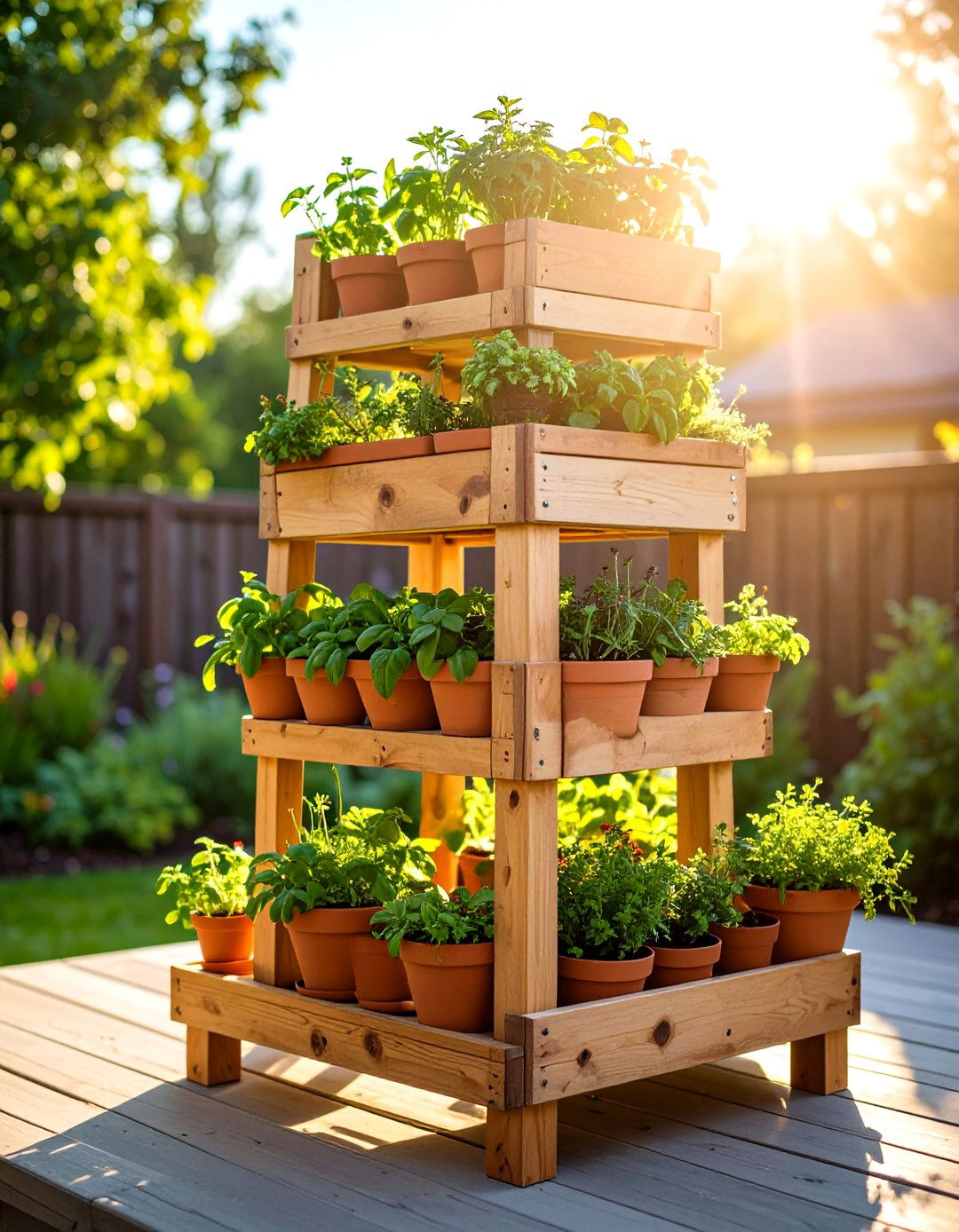
Strawberry pot herb gardens utilize multi-tiered terracotta containers with side pockets to accommodate numerous herb varieties in compact vertical arrangements. Plant trailing herbs like thyme and oregano in side pockets while reserving the top opening for upright varieties like basil or rosemary. The tiered design provides natural drainage flow while allowing each plant adequate space for root development. This traditional container style complements Mediterranean and cottage garden aesthetics while providing excellent thermal regulation for plant roots. Regular watering from the top ensures all levels receive adequate moisture while the terracotta material allows proper air circulation.
15. Kitchen Cart Rolling Herb Garden Station

Transform a kitchen cart into a mobile herb garden station that moves seamlessly between indoor and outdoor locations based on weather conditions and growing requirements. Install grow lights underneath upper shelves for winter growing while utilizing natural light during favorable weather. The multiple levels accommodate various container sizes while providing storage for gardening tools, watering supplies, and harvesting baskets. This system proves especially valuable for urban gardeners or those with limited permanent growing space, offering flexibility while maintaining professional organization. The mobility allows for optimal light chasing while protecting tender herbs during extreme weather conditions.
16. Concrete Block Raised Herb Garden Bed
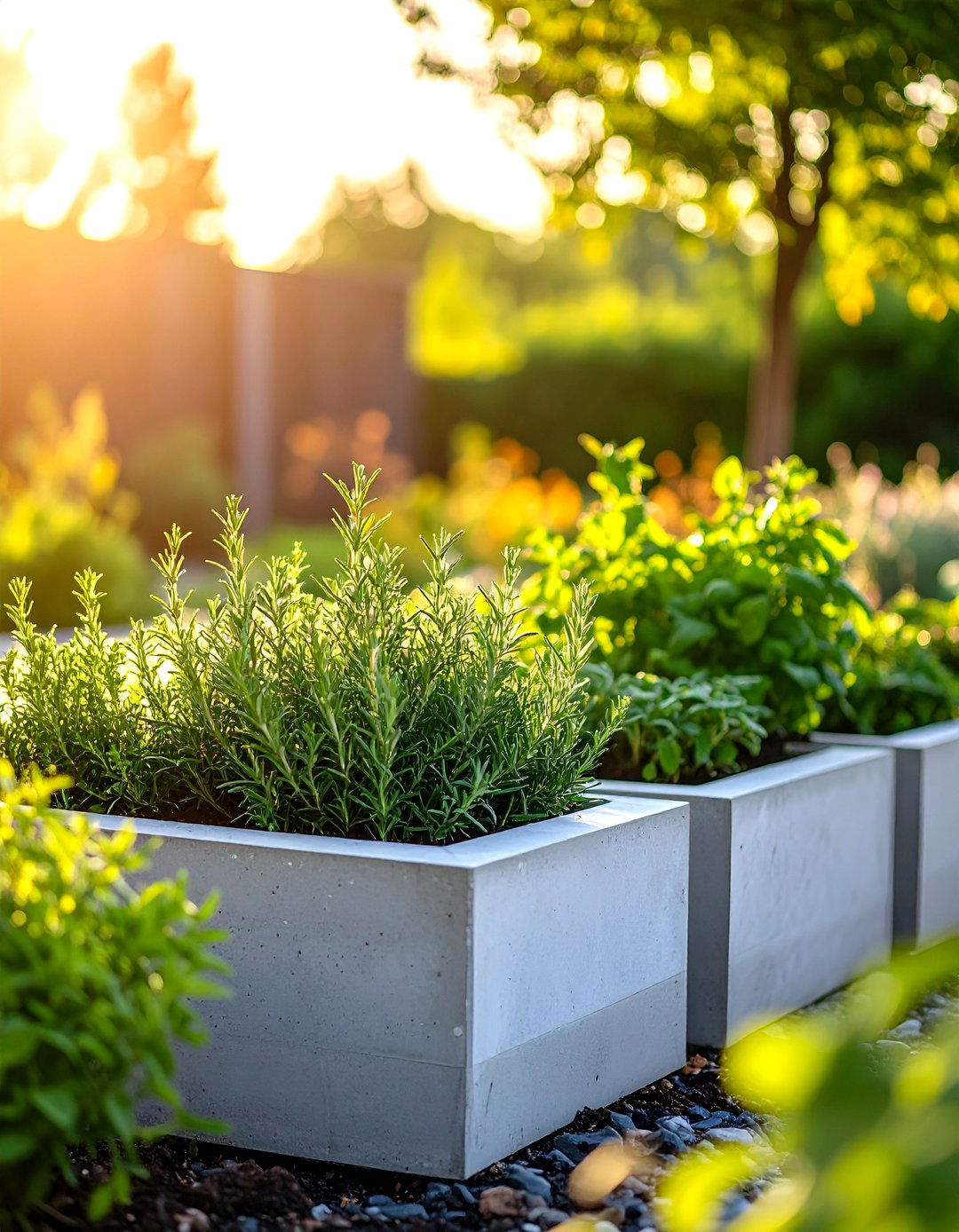
Concrete block herb gardens create permanent raised bed structures that provide excellent drainage, thermal mass, and organized growing spaces for extensive herb collections. Stack blocks to desired height while leaving gaps for drainage and root expansion, filling the structure with quality soil amended with compost. The blocks' thermal properties help regulate soil temperature while the raised design improves drainage and accessibility. Plant herbs according to mature size and growing requirements, positioning taller varieties toward the back while allowing trailing types to cascade over edges. This durable construction method provides long-term growing solutions for serious herb gardeners.
17. Wine Barrel Half Herb Garden Container

Wine barrel herb gardens combine rustic charm with substantial growing capacity, accommodating extensive herb collections in attractive, weathered containers. The curved design provides excellent drainage when proper holes are drilled, while the substantial size allows for diverse plantings including larger herbs like rosemary and lavender. Position barrels strategically to create garden focal points while ensuring adequate sunlight exposure for planted herbs. The oak construction weathers beautifully while providing insulation for plant roots during temperature fluctuations. This container style complements vineyard aesthetics while offering professional-quality growing conditions for serious culinary herb production.
18. Repurposed Dresser Drawer Herb Garden

Convert old dresser drawers into unique herb garden containers that add vintage character while providing adequate growing space for shallow-rooted herb varieties. Line drawers with landscape fabric and drill drainage holes before filling with quality potting soil suitable for container growing. These repurposed containers work beautifully for themed herb collections like tea herbs, pizza herbs, or salad enhancement varieties. The rectangular shape provides efficient space utilization while the vintage aesthetic adds personality to garden spaces. Position multiple drawers at varying heights to create interesting displays while ensuring proper light exposure for all planted herbs.
19. Chicken Wire Cage Herb Garden Structure

Chicken wire herb gardens create protective growing environments while adding architectural interest through cylindrical or rectangular cage structures filled with growing medium. Line the interior with landscape fabric to retain soil while allowing proper drainage, creating substantial growing volume for larger herb collections. This method works particularly well for herbs that benefit from wind protection while providing excellent air circulation. The wire structure supports climbing or sprawling herbs while protecting against rabbits and other ground-dwelling pests. Regular harvesting maintains plant health while the protective structure extends the growing season in challenging climates.
20. Tiered Ladder Planter Herb Garden Showcase
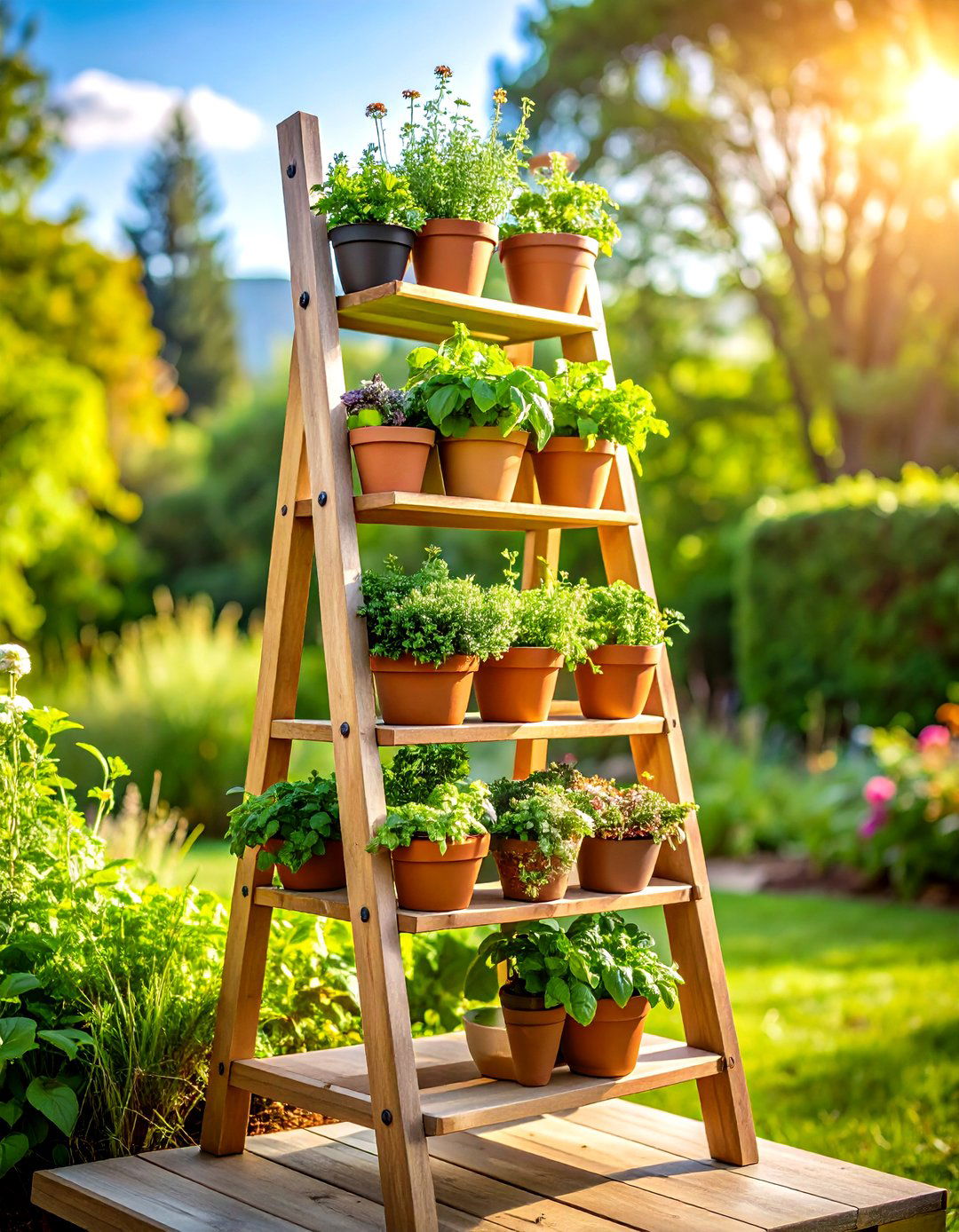
Create an impressive tiered ladder planter herb garden by positioning progressively smaller containers on wooden ladder rungs to form a pyramid-shaped growing display. This arrangement maximizes growing space while creating stunning visual impact through varied heights and cascading plant arrangements. Position sun-loving herbs at the top where light exposure is greatest, while placing shade-tolerant varieties lower in the arrangement. The tiered design provides natural drainage flow while allowing each level adequate light exposure. This showcase method proves perfect for herb enthusiasts who want to display extensive collections while maintaining organized, accessible growing conditions for daily harvesting and maintenance.
Conclusion:
These twenty herb garden ideas demonstrate that fresh, flavorful herbs are accessible regardless of your space limitations, budget, or gardening experience. From simple windowsill collections to elaborate spiral gardens, each approach offers unique benefits while providing the satisfaction of homegrown ingredients. Choose methods that match your lifestyle and available space, then expand your herb growing repertoire as confidence and experience develop. With proper planning and consistent care, any of these creative approaches will supply your kitchen with aromatic, fresh herbs while adding natural beauty to your living environment.





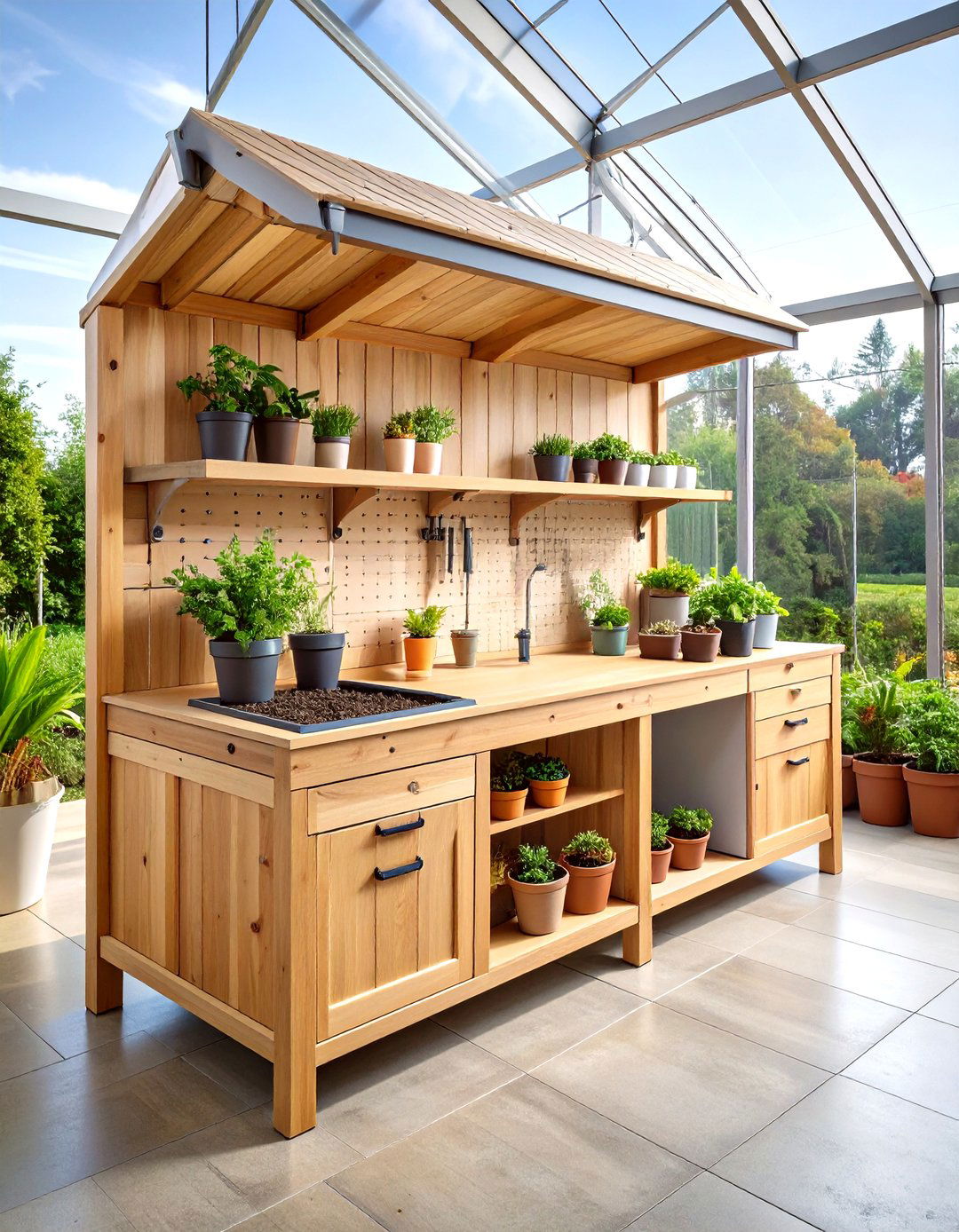
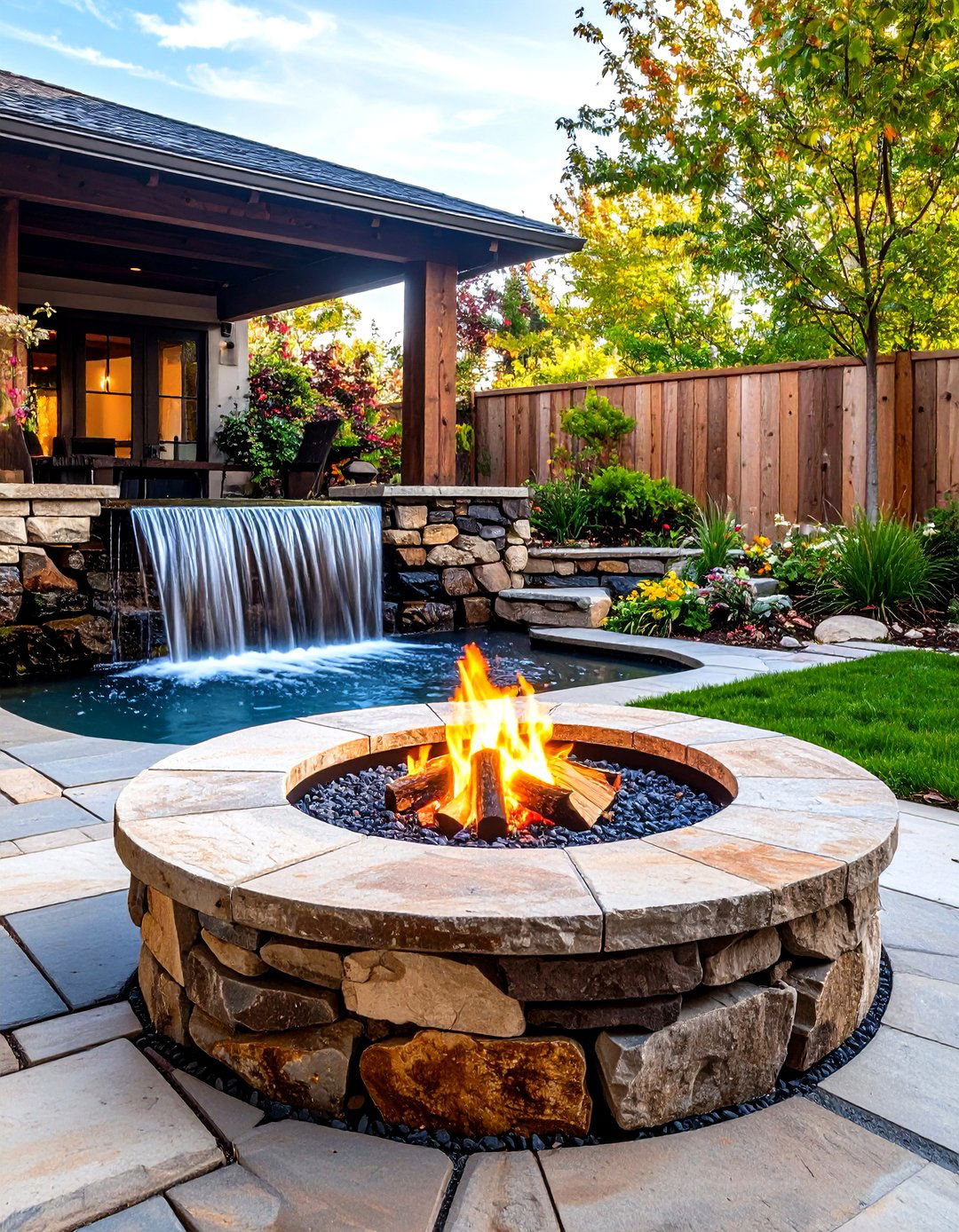



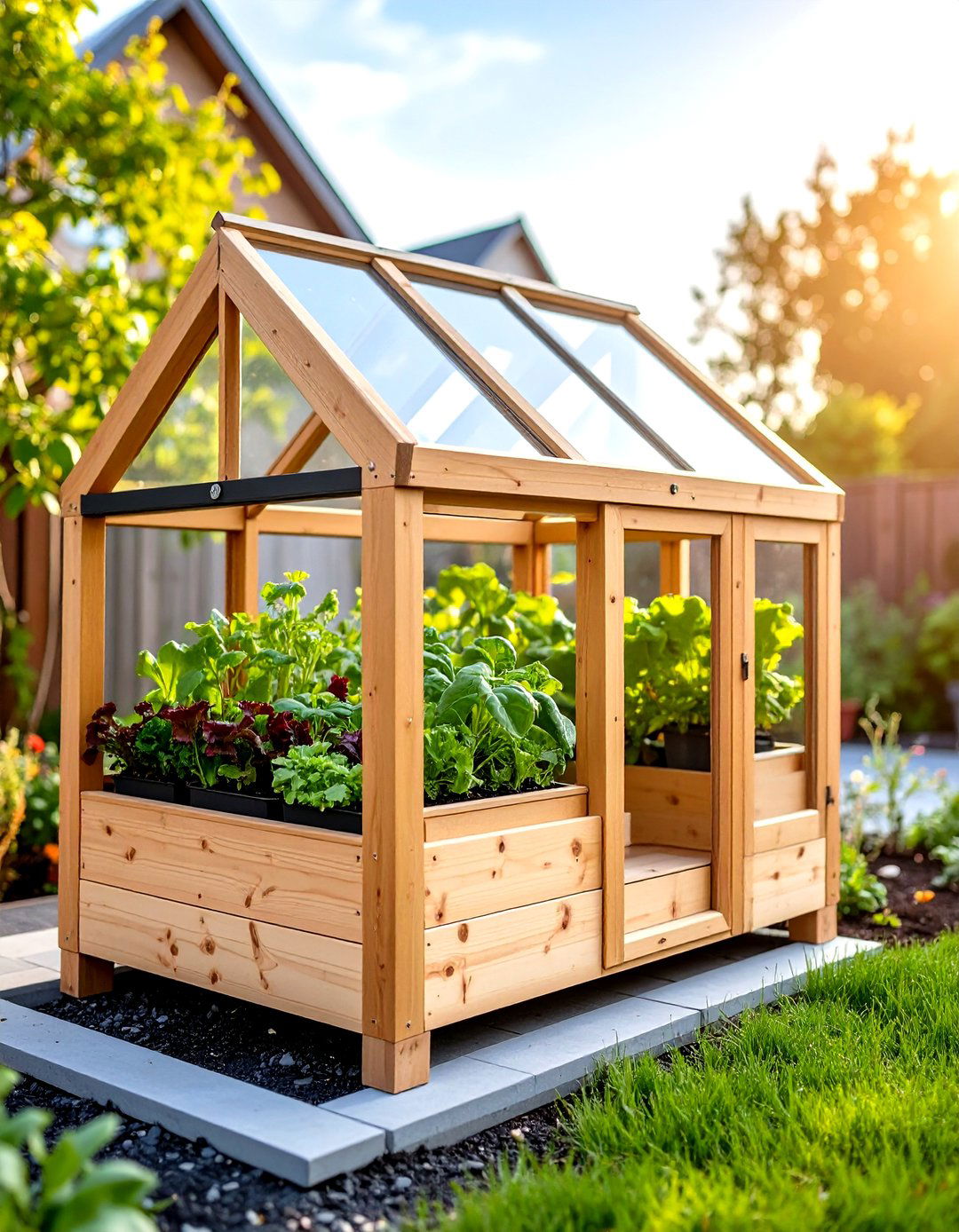
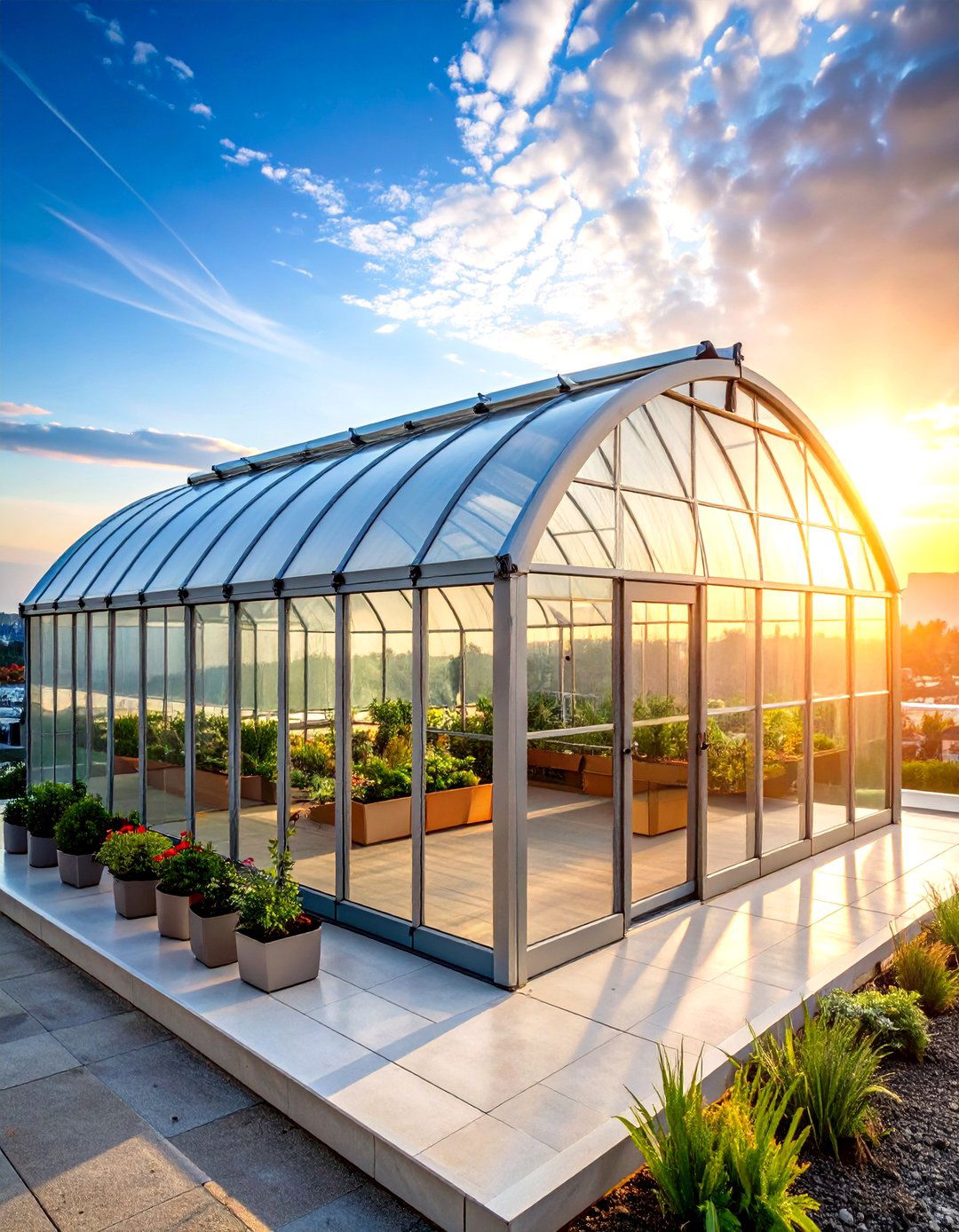
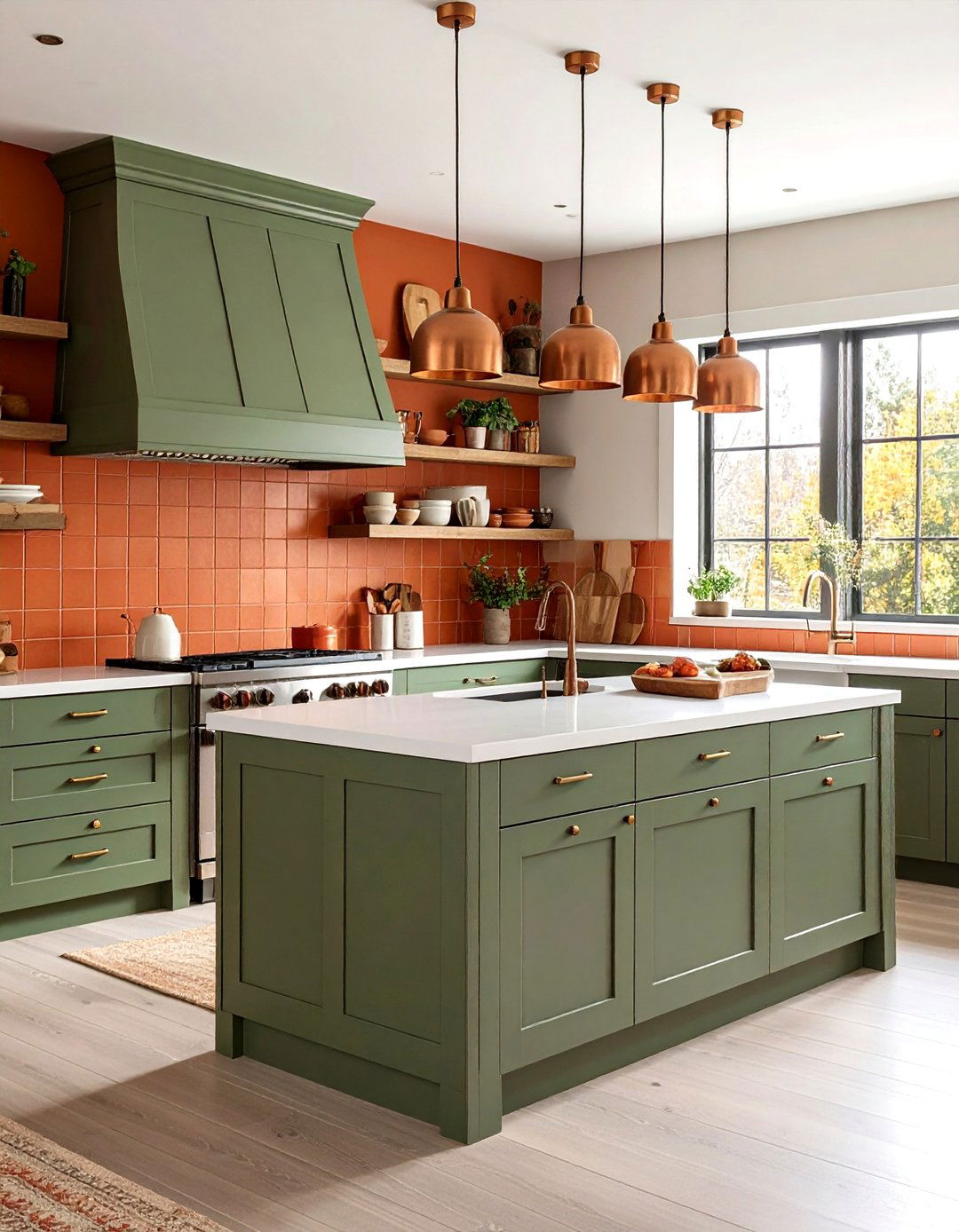


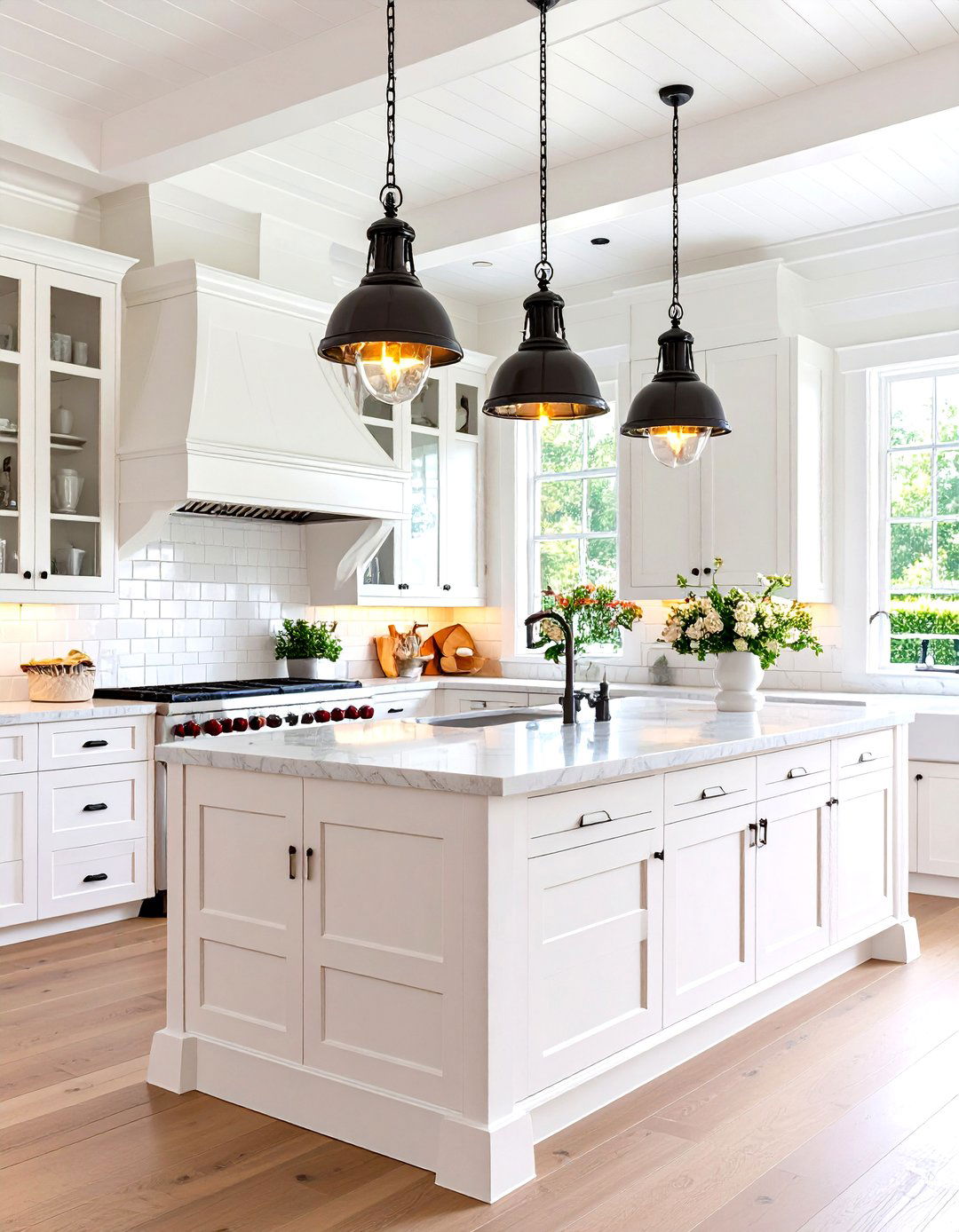
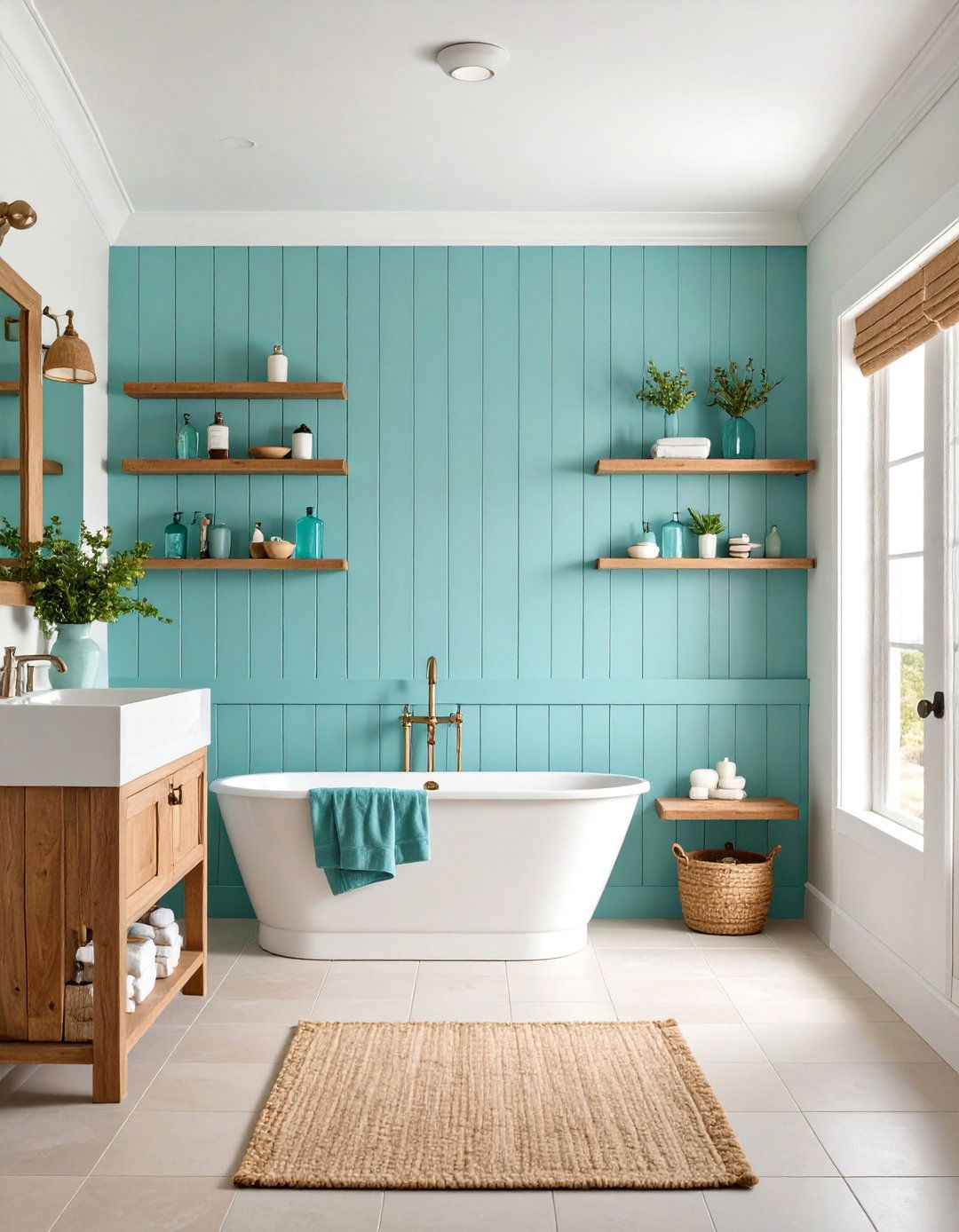
Leave a Reply